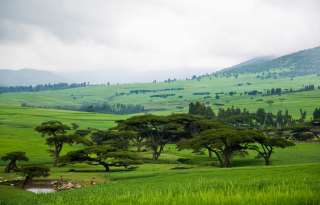|
|
|
Unique among African countries, the ancient Ethiopian monarchy maintained its freedom from colonial rule with the exception of a short-lived Italian occupation from 1936-41. Ethiopia is the second most populous country in Africa. More than 70% of Ethiopia’s population is still employed in the agricultural sector, but services have surpassed agriculture as the principal source of GDP. Ethiopia has the lowest level of income-inequality in Africa and one of the lowest in the world.
Profiles
 The Federal Democratic Republic of Ethiopia (FDRE) is located in the horn of Africa, bordering with Eritrea in the north, Sudan and South Sudan in the west, Somalia and Kenya in the south and Somalia and Djibouti in the east. The total land area is 999,541 sq. km (385,925 sq. miles) and is home to 73 million inhabitants. It covers an area of 1,127,127 sq. km, of which an estimated 34% is agricultural, 9.6% is arable, an estimated 3.6% is forested, and 48.9% is covered by woodlands and shrubs. Only 4.5% of arable land is irrigated. Protected areas encompass 14% of Ethiopia's land area. An estimated 15% of Ethiopia's approximately 80.7 million people live in urban areas, making it one of the least urbanized counties in the world.
The Federal Democratic Republic of Ethiopia (FDRE) is located in the horn of Africa, bordering with Eritrea in the north, Sudan and South Sudan in the west, Somalia and Kenya in the south and Somalia and Djibouti in the east. The total land area is 999,541 sq. km (385,925 sq. miles) and is home to 73 million inhabitants. It covers an area of 1,127,127 sq. km, of which an estimated 34% is agricultural, 9.6% is arable, an estimated 3.6% is forested, and 48.9% is covered by woodlands and shrubs. Only 4.5% of arable land is irrigated. Protected areas encompass 14% of Ethiopia's land area. An estimated 15% of Ethiopia's approximately 80.7 million people live in urban areas, making it one of the least urbanized counties in the world.
The Federal Democratic Republic of Ethiopia (FDRE) comprises of the Federal Government and the State members. Ethiopia is a Federal State which is constituted of two special administrative cities (Addis Ababa and Dire Dawa) that are accountable to the Federal Government and nine other administrative national regional states governed by their own State Councils. The powers and responsibilities of the Federal and State Governments are provided in the Constitution. Except for those powers exclusively vested with the Federal Government, Regional States have full power to decide on their internal administrative land matters.
Read More on folder Profiles...



